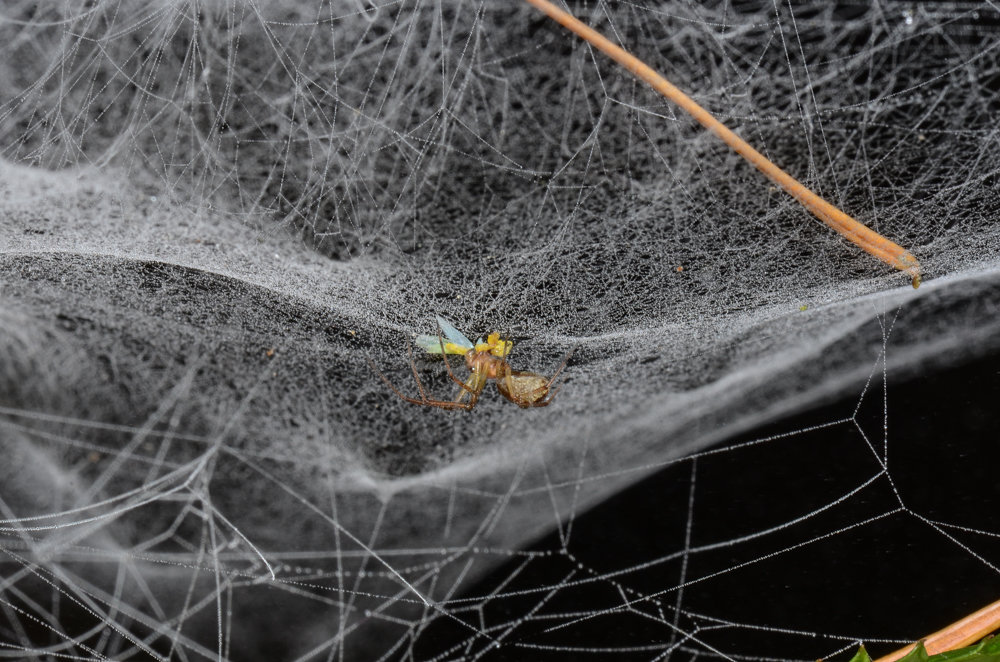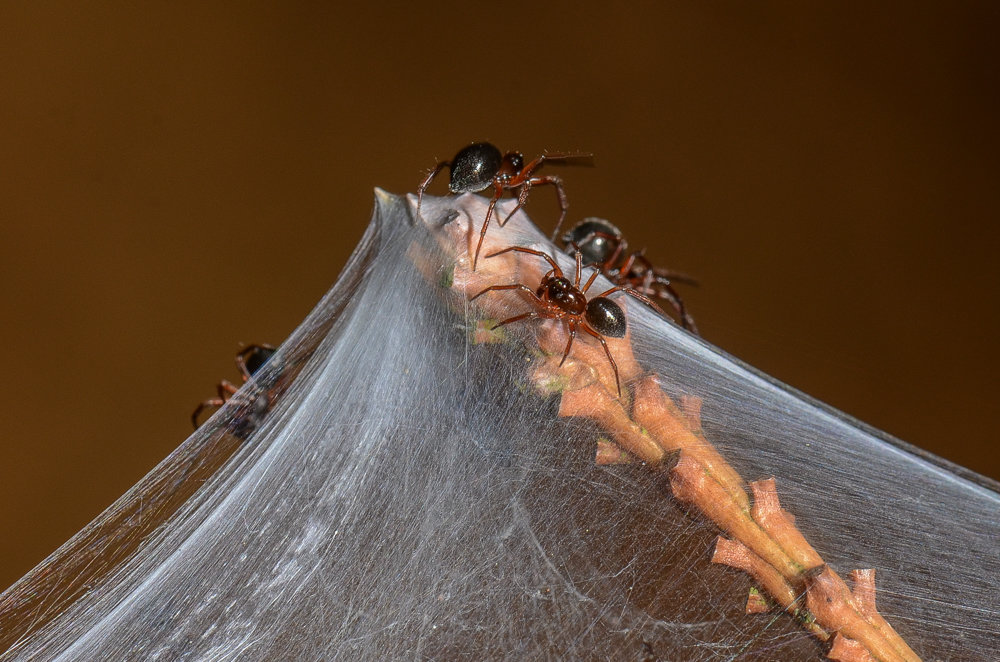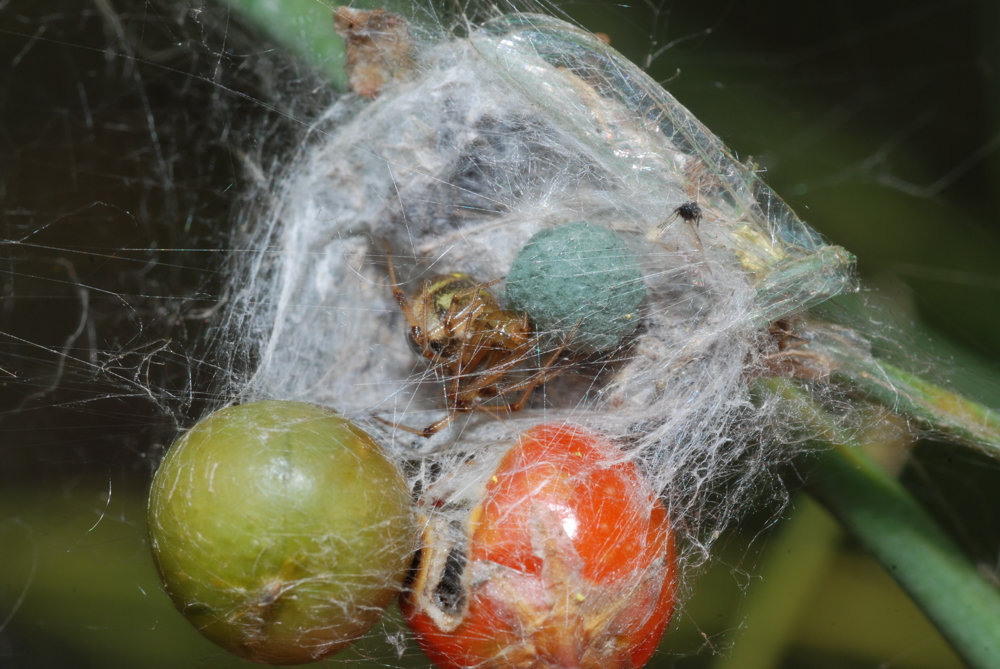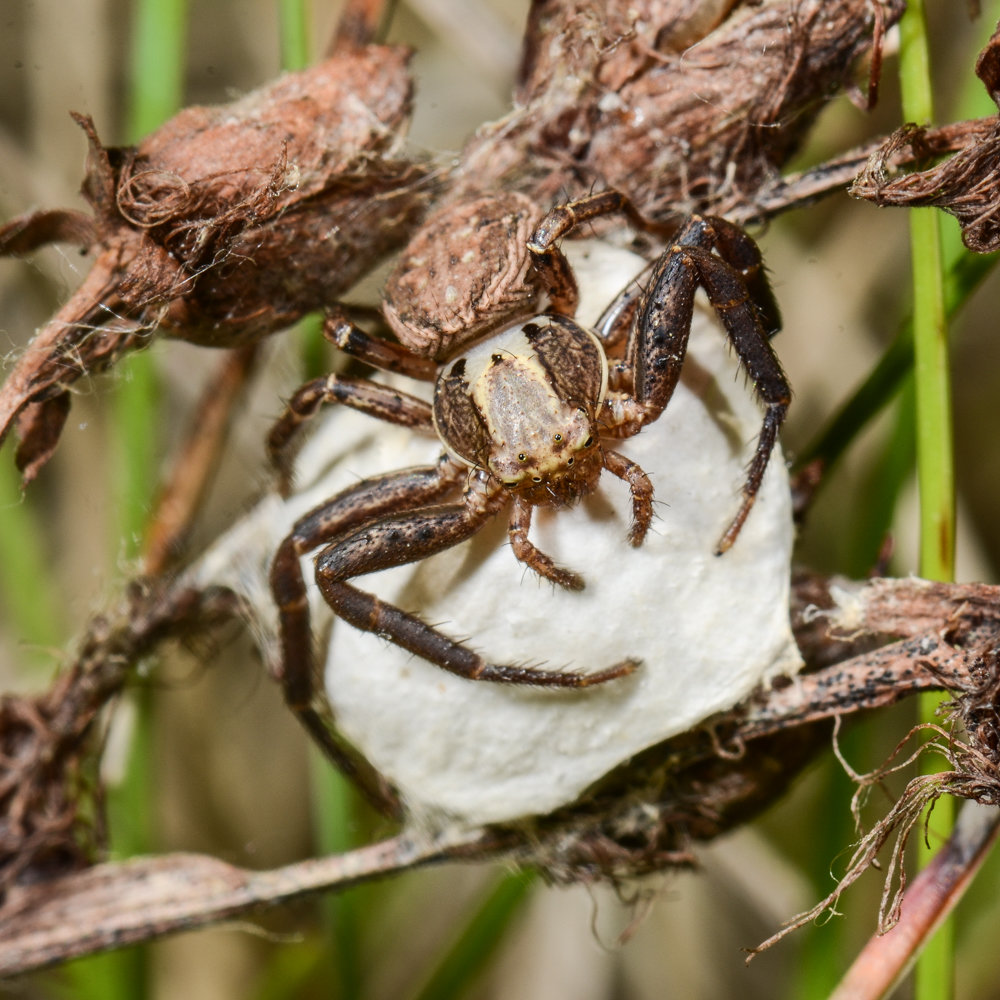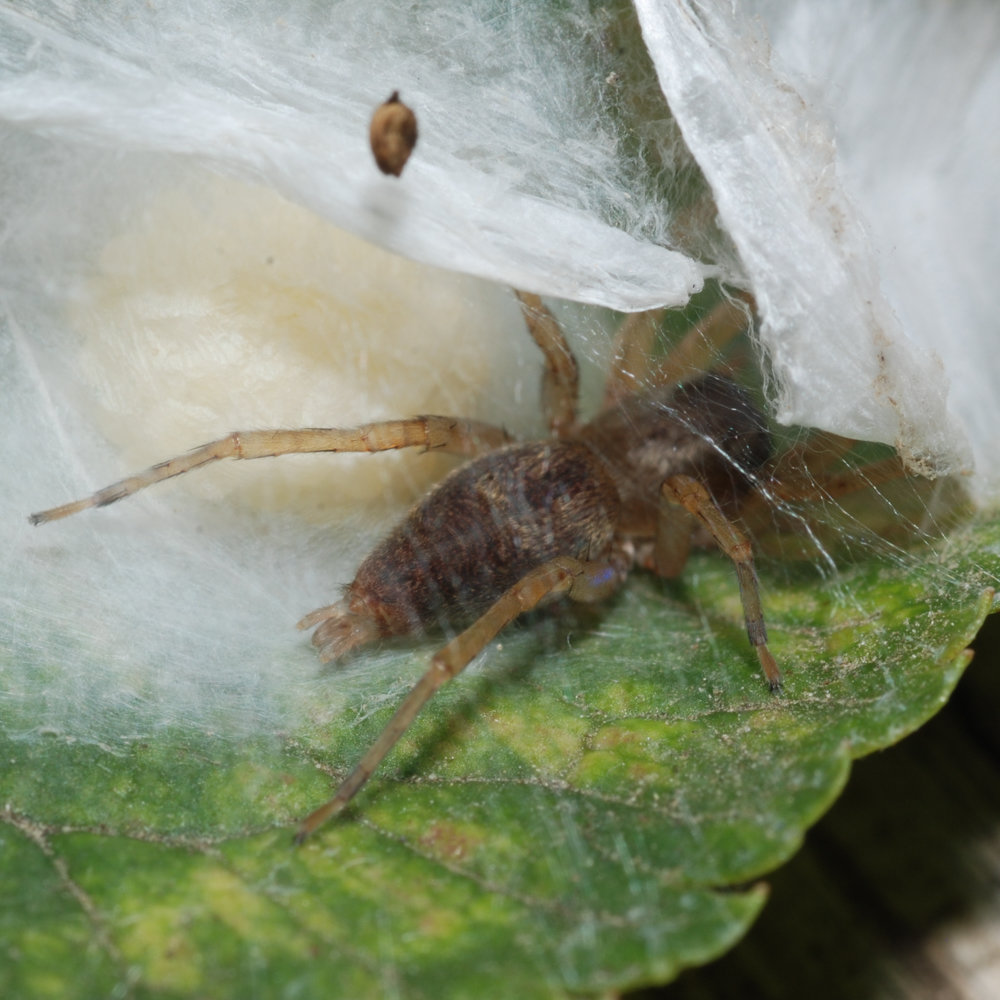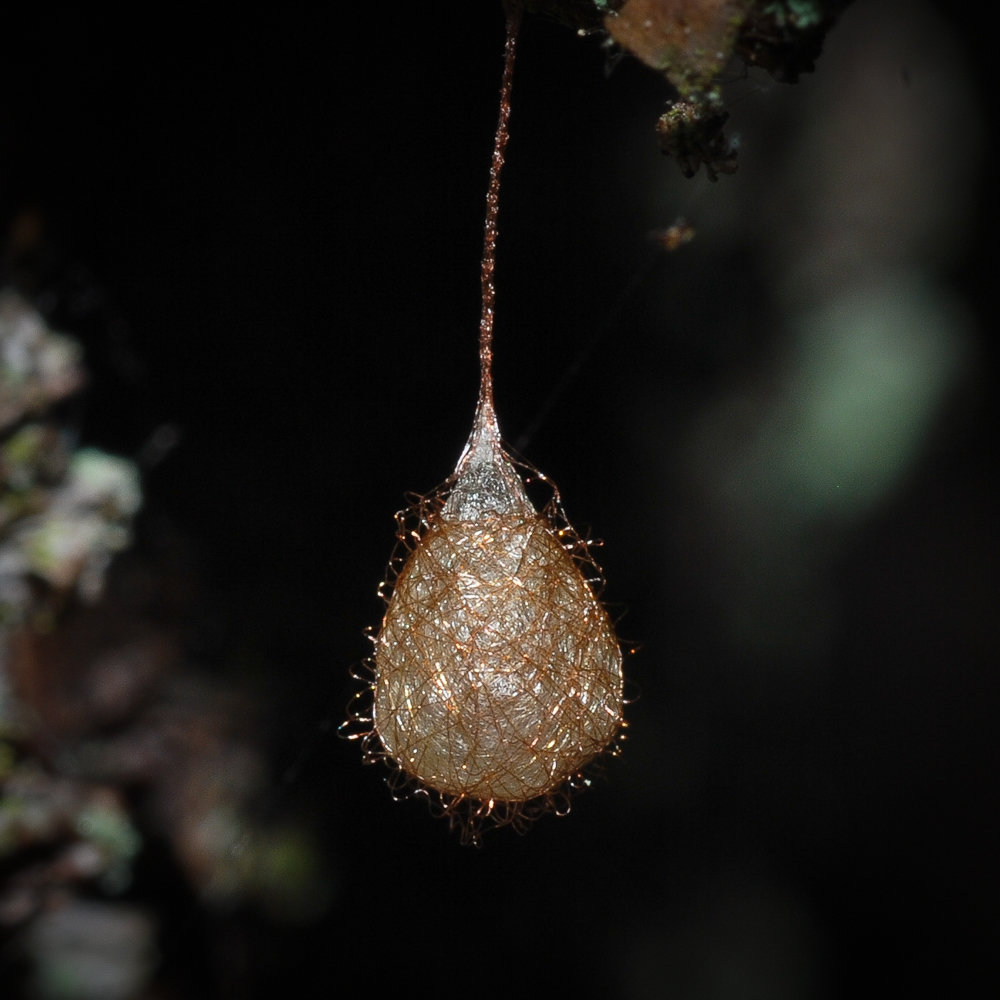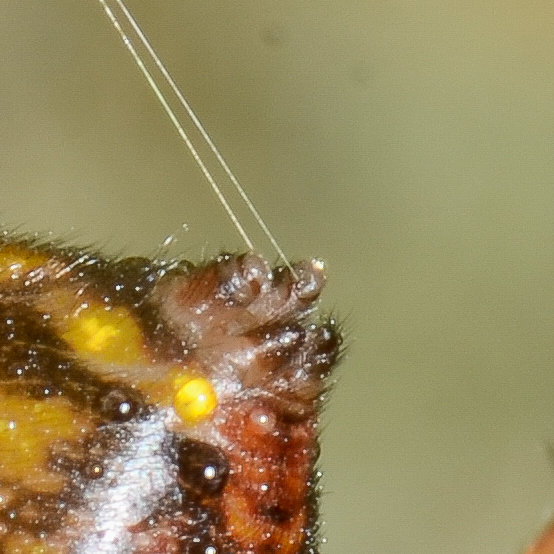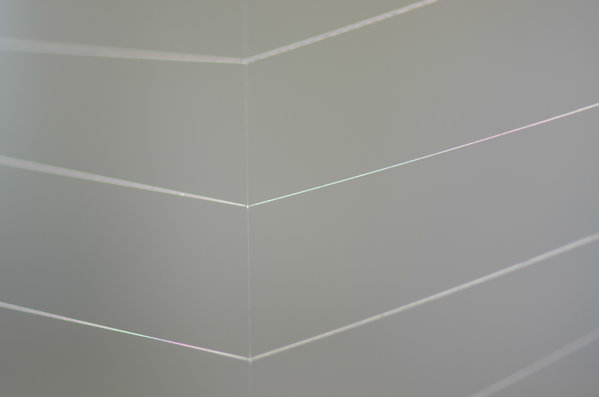SILK PRODUCTION AND SPINNING
The ability to produce silk has been developed several times independently among animals, probably 23 times by insects and once each in crustaceans, millipedes, mites, pseudoscorpions and spiders. A silk of importance to humans is produced mostly by the silkworm (the caterpillar of Bombyx mori, a butterfly) and web spiders. In contrast to the butterflies and also to almost all other silk-producing animals, spiders produce silk during their entire life cycle and most species are able to produce more than one type of silk, each according to its ecological function.
Spiders are usually associated to their silk-spinning ability and their webs. And indeed, all true spiders (Araneae) are capable of producing silk in specialized glands and apply it very efficiently as threads by means of their spinnerets. But not all spiders use their silk for prey catching; many spiders hunt their prey actively or in ambush. Such „hunting spiders“ use silk for the construction of securing or signal threads, to make their retreats and egg sacs.
Among the “web-building spiders“ on the other hand, there are a number of different web types and means of prey-handling associated with it. First, the web transmits signals to the spider while at the same time keeping the prey in the web at least for such an amount of time, which is necessary to apply a poisonous bite or entangle the prey with silk. To this end a certain type of catching thread has developed during the course of evolution, covered with a sticky substance. These so-called sticky-thread spiders all belong to the orb weavers, like the common garden spiders.
Another technique, the one of the cribellate (hackle band-producing) spiders, is particularly effective in its making use of hackle bands. These hackle bands of many single and very thin wool-like brushed threads are made with a special spinning apparatus, the cribellum (a sieve-like plate) and a kind of comb, the calamistrum. That is why these spiders are called cribellate spiders.
Silk production is vital to spider biology. First it is essential to reproduction, since the males first transfer their sperm onto a small web and take it up by a their secondary copulation organs, the palps, which function like a pipette. Second silk ist used to produce cocoons to protect the eggs in all spider species. Therefore, the silk-spinning ability has certainly contributed substantially to the evolutionary success of the spiders.
Spiders have a history of about 350 million years (dating back to the Carboniferous) and the ability to produce silk has been developed only once among the species-rich order of spiders (44,000+ extant species). Therefore, on the molecular level the evolution of silk to a large extent mirrors the morpholocial and physiological evolution of spiders. Primitive spiders (Mesothelae) and tarantulas (Mygalomorphae) both differ from the modern orb-weaving spiders in number and structure of their silk proteins.
In all spiders the silk is produced in specialized glands in the hind body; their cells secrete proteins into their cavities, which through thin ducts lead to the tiny spigots on the larger spinnerets. Each gland is connected to a certain spigot type. Inside of the gland the silk is liquid, with the proteins being highly concentrated within a watery solution. Inside the gland duct, shearing forces, the extraction of water and an exchange of ions result in the proteins arranging parallel and becoming water-repellent silk.
Especially in orb-weaving species, there are up to seven different kinds of spinning glands in a spider species:
- large ampullate glands utilized for abseiling-, securing- and frame threads in the web
- smaller ampullate glands for the construction of the auxiliary spiral in the orb web
- flagelliform glands for the radial threads
- aggregate glands for the sticky threads
- cylindrical glands for the outer cocoon threads
- aciniform gland for the inner cocoon threads and for entangling the prey-catching
- pyriform glands for fastening the securing threads to the surface.
There is, however, in each spider group (taxon) quite a variability in presence, morphology and number of spinning glands, and therefore also in the kinds of spider silk produced.
The Araneoidea (species related to the orb-weaving spiders) can produce 300 different silk threads and emit them through their spigots. The sperm web of spider males is made to a large degree by aciniform silk, but also by “silk” produced in glands discharging through the genital opening (in contrast to the spinnerets!).
Spider silk basically consists of fibrous proteins called ‘spidroins‘ (spider fibroins). So far, only a small number of whole gene sequences (11,000 base pairs) of such spidroins are known. These proteins are very long (appr. 3,700 amino acids) and consist of a highly repetitive core sequence (with a high proportion of glycine, alanine and serine) and similar N- and C-terminals. These very conservative segments presumably play a large role in making the thread and, in contrast to the fibroins, only occur in spiders.
Considering their light weight, spider threads are mechanically unequaled by all biological and most of the technical materials concerning strength, elasticity and tensile strenght (energy absorption). They are also interesting because of their being produced at room temperature from water and non-toxic substances; they are bio-compatible, e.g. as implants, and biologically degradable. Flagelliforme threads can reversibly be stretched to about 300 % without rupturing.
There are, however, large differences between the spider silks of the spinning glands in different spider species, genera etc. (taxa). Only a number of larger species of the orb-web weaver genera Nephila, Argiope and Araneus have so far been well studied because only they produce a considerable amount of silk. Due to their small genome sizes and easy rearing, possible model organisms for spider silk production are Latrodectus hesperus, Parasteatoda tepidariorum and Cupiennius salei.
Only in recent years have processes been developed for an artificial making of spider silk, including the use of transgenic bacteria as well as technical ways of making threads from such artificial spider silk.
- Cetinkaya, M., Xiao, S., Markert, B., Stacklies, W. & Gräter, F. 2017: Silk Fiber Mechanics from Multiscale Force Distribution Analysis. – Biophysical Journal 100: 1298–1305.
- Garb, J. 2013: Spider silk: An ancient biomaterial for the 21st century. In: Spider Research in the 21st Century – trends & perspectives. Siri Scientific Press, Manchester, UK.
- Gosline, J.M., Guerette, P.A., Ortlepp, C.S. & K.N. Savage 1999: The mechanical design of spider silks: from fibroin sequence to mechanical function. The Journal of Experimental Biology 202: 3295–3303.
- Heim, M., Keerl, D. & Scheibel, T. 2009: Spider silk: from soluble protein to extraordinary fiber. Angew. Chem. Int. Ed Engl. 48: 3584–96.
- Körner, M. 2017: Künstliche Spinnenseide: Forscher entwickeln chemische Spinndrüse. www.chemreporter.de/2017/01/24/supermaterial-forscher-entwickeln-chemische-spinnen
- Omenetto,F.G. & D.I. Kaplan 2010: New opportunities for an ancient material. Science 329: 528-531.
- Scheibel, T. 2004: Spider silks: recombinant synthesis, assembly, spinning, and engineering of synthetic proteins. Micob. Cell Fact. 3: 14. doi: 10.1186/1475-2859-3-14
- Schulte, A.J. 2014: Künstliche Spinnenseide. Europäische Sicherheit und Technik (Fraunhofer INT): S. 106. PDF



